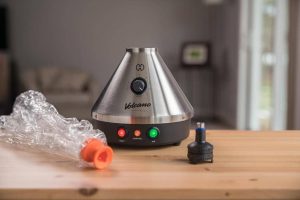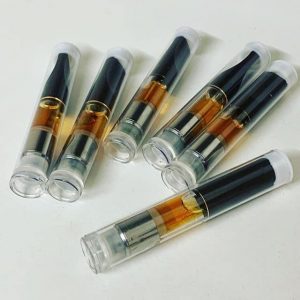Vaporising cannabis is an important delivery method for many medicinal users. ‘Vaping’ is a quick and comparatively safe way to access the medicinal benefits of cannabis.
This article will explore the main advantages to vaping, and then will address some key issues around how to choose a vaporiser out of the many options now on the market. Along the way we will look at some relevant questions such as whether it is harmful to smoke or vape cannabis, and how to get the best out of a vaporiser.
What is vaping?
Vaporiser devices heat cannabis to a temperature just hot enough to evaporate the medicinal compounds so that they can be inhaled, ideally without making the cannabis hot enough to actually burn it. A variety of vaporisers are now manufactured specifically for cannabis use, with models ranging from inexpensive portable devices to more high-tech stay-at-home models.
Why vape?
Vaporising cannabis is a great option for patients wanting quick, short-term symptom relief. The effects of vaporised cannabis are felt within a few minutes. In comparison, it can take up to two hours for an orally ingested cannabis product to take full effect.
The health impacts of vaping are considerably gentler than smoking cannabis. Smoking cannabis is not the worst thing in the world; it is far less harmful than smoking tobacco. Moderate cannabis smoking has not been linked to lung cancer or lung-obstructing diseases (1). However, smoking cannabis has been shown to have negative respiratory effects for some users, including increased coughing, sputum production and wheezing (2).
Only a small number of studies have looked at vaporising cannabis. These studies have clearly shown that vaping cannabis has health advantages over smoking it. The advantages include a lowered risk profile, and greater availability of medicinal compounds.
A survey of cannabis users found that vaporiser users were only 40% as likely to report respiratory symptoms, compared to users who did not use a vaporiser (3). The health benefits of vaping were most pronounced for more intensive cannabis users (3). In another study, frequent cannabis users who reported respiratory problems found that their respiratory symptoms improved in just a month when they switched to a vaporiser (4).
Laboratory analysis has shown that the vapour from a high-quality cannabis vaporiser contains mostly therapeutic compounds (5). In contrast, the same study found that cannabis smoke contained over 111 different compounds, including some considered to be toxic, particularly pyrene and other polynuculear aromatic hydrocarbons (PAHs).
It’s worth noting that there is a lack of long-term studies on vaping. However, vaping dried cannabis flowers (buds) is considered comparatively safe at this time.
Efficient use of cannabis
Another great reason to use a vaporiser is that it uses cannabis more efficiently than smoking. Unsurprisingly, a lot of good medicinal compounds are wasted when cannabis is lit on fire. Smoking cannabis only makes a small percentage of the herb’s THC available to the smoker, ranging from an average of 12% THC availability in one study (6) to 19-27% in another study (7). In contrast, a high quality vaporiser typically makes over 50% of the herb’s THC and CBD available to the user (8, 9).
Choosing a vaporiser
One of the main considerations in choosing a vaporiser is whether to buy a portable or ‘desktop’ model. The first question to consider is convenience: Do you want to vape on the go, or will you only be vaping at home? Portable vaporisers are generally lightweight and easy to carry, while desktop units often offer a more high-tech vaping experience.
Some desktop models offer advanced features that are helpful for some users. For example, some desktop models come with a ‘balloon’, essentially a reusable plastic bag which stores the vapour, which can then be sipped slowly for hours if desired. A balloon also allows the vapour to cool down before inhaling, which can benefit more sensitive users.
[caption id="attachment_7238" align="alignright" width="266"] The Volcano is the gold standard in desktop vapes and comes in a Medical device variant.[/caption]
The Volcano is the gold standard in desktop vapes and comes in a Medical device variant.[/caption]
Another consideration in choosing a vaporiser is the mode of heating. Most vaporisers heat cannabis through one of two main methods: conduction and convection. Conduction involves directly heating the cannabis with a hot surface; this is a less expensive technology but is also a lower-precision mode of heating. Heat is distributed unevenly inside the vaping chamber, so temperature is less precisely controlled.
Convection, on the other hand, involves passing hot air over the cannabis. This creates more uniform vaporisation, which can result in more efficient cannabis use and the smoothest vapour. However, convection tends to come with a higher price point for the machine.
Another consideration is whether to vape dried herbal cannabis, or whether to vape concentrated cannabis oil. Vaping oil needs to be approached with caution, depending on what additives have been combined with the cannabis oil to keep it in a liquid state. For example, in overseas markets, cannabis oil for vaping is often mixed with propylene glycol. Propylene glycol can cause respiratory problems and also produces carcinogens when vaporised – the opposite of a healthy experience.
[caption id="attachment_7239" align="alignright" width="175"] In the USA, quality control has been lax, leading to some heavy metal contamination in vaporizer cartridges.[/caption]
In the USA, quality control has been lax, leading to some heavy metal contamination in vaporizer cartridges.[/caption]
Some cheaply made cannabis oil vaporiser cartridges have also been found to leach heavy metals (10). So, while vaping concentrated cannabis oil is not inherently dangerous, it pays to be careful around commercially made cannabis oil vaporisers.
Choosing your temperature
A final reason that many medicinal cannabis users like to use a vaporiser is because the user can select for specific medicinal effects by adjusting the vaporiser’s temperature. Most vaporisers come with the ability to choose from a variety of temperature settings.
Generally, the recommended temperature range for vaporising cannabis is between 170-210°C. Different medicinal compounds evaporate at different temperatures. This means that by choosing a specific temperature, a user can choose which compounds will predominate in their cannabis vapour.
At lower temperatures, the vapour will be more dominated by terpenes and will be lower in cannabinoids, creating a lighter effect that can boost cerebral focus and can be helpful for stress and anxiety.
At higher temperatures, the cannabinoids (including THC and CBD) become more dominant, leading to a stronger body-focused medicinal experience. A user can even vape the same batch of herb twice: once during the day at a lower temperature for a lighter effect, and then again at night for deeper body relaxation.
Happy vaping!
MCANZ now offers a small range of Vaporising products selected for their ease of use (for those lacking dexterity in their hands), longevity (replaceable batteries) overall quality and price, click here to see our range of vaporisers.
Article was written by Rebecca (Redwood) Reider
References
(1) Tashkin, D. P. (2013). Effects of marijuana smoking on the lung. Annals of the American Thoracic Society, 10(3), 239-247.
(2) Tetrault, J. M., Crothers, K., Moore, B. A., Mehra, R., Concato, J., & Fiellin, D. A. (2007). Effects of marijuana smoking on pulmonary function and respiratory complications: a systematic review. Archives of I__nternal M__edicine, 167(3), 221-228.
(3) Earleywine, M., & Barnwell, S. S. (2007). Decreased respiratory symptoms in cannabis users who vaporize. Harm Reduction Journal, 4(1), 11.
(4) Van Dam, N. T., & Earleywine, M. (2010). Pulmonary function in cannabis users: support for a clinical trial of the vaporizer. International Journal of Drug Policy, 21(6), 511-513.
(5) Gieringer, D., St. Laurent, J., & Goodrich, S. (2004). Cannabis vaporizer combines efficient delivery of THC with effective suppression of pyrolytic compounds. Journal of Cannabis Therapeutics, 4(1), 7-27.
(6) Sheehan, T. J., Hamnett, H. J., Beasley, R., & Fitzmaurice, P. S. (2018). Chemical and physical variations of cannabis smoke from a variety of cannabis samples in New Zealand. Forensic Sciences Research, 1-11.
(7) Hädener, M., Vieten, S., Weinmann, W., & Mahler, H. (2019). A preliminary investigation of lung availability of cannabinoids by smoking marijuana or dabbing BHO and decarboxylation rate of THC-and CBD-acids. Forensic S__cience I__nternational, 295, 207-212.
(8) Hazekamp, A., Ruhaak, R., Zuurman, L., van Gerven, J., & Verpoorte, R. (2006). Evaluation of a vaporizing device (Volcano®) for the pulmonary administration of tetrahydrocannabinol. Journal of Pharmaceutical S__ciences, 95(6), 1308-1317.
(9) Lanz, C., Mattsson, J., Soydaner, U., & Brenneisen, R. (2016). Medicinal cannabis: in vitro validation of vaporizers for the smoke-free inhalation of cannabis. PLoS One, 11(1), e0147286.
(10) Colbert, M. (2019). Cannabis Cartridges Have a Heavy Metal Problem & It Is Worse Than Reported. Cannabis Now. https://cannabisnow.com/cannabis-cartridges-have-a-heavy-metal-problem-it-is-worse-than-reported/
